The Power of Convening
The Institute of Medicine’s (IOM) convening activities—forums, roundtables, workshops, summits, and symposia—provide a different approach to exploration of issues in science and public policy. As the term suggests, convening activities draw together diverse parties who have shared interests in the health sciences. Workshops, summits, and symposia are designed to explore tightly defined topics, such as the contribution of lifestyle factors to premature death. Symposia may also be held as part of dissemination activities for a report. A series of symposia on the subject of childhood obesity has served to bring the subject, and the IOM’s report, to the attention of regional media markets. Forums and roundtables, in contrast, are held to bring together a community of stakeholders interested in a broad area of health science policy for a long-term, evidence-based dialogue. Members of forums or roundtables include individuals from the relevant scientific and practice communities; leaders from government, academia, and industry; and representatives from consumer and public interest groups. The purpose is not to directly resolve pressing issues, but rather to illuminate them through dialogue and discussion across sectors and institutions. This bringing together of individuals who reflect key institutional interests in a particular field plays a very powerful role in creating the shared knowledge, trust, and understanding needed to enable progress in difficult areas of health and science policy.
|
This bringing together of individuals who reflect key institutional interests in a particular field plays a very powerful role in creating the shared knowledge, trust, and understanding needed to enable progress in difficult areas of health and science policy. |
FORUMS AND ROUNDTABLES
Examples from some of the IOM’s convening activities illustrate the range of topics they cover.
FORUM ON MICROBIAL THREATS
In its 1992 report Emerging Infections: Microbial Threats to Health in the United States, the IOM pointed to some major challenges for the public health and medical care communities in detecting and managing infectious disease outbreaks and monitoring the prevalence of endemic diseases. In response, the
Centers for Disease Control and Prevention (CDC) developed a national strategy for doing so and, with the National Institutes of Health’s National Institute for Allergy and Infectious Diseases, asked the IOM to convene a Forum on Microbial Threats that would serve as a follow-up activity for these initiatives. The Forum provides a structured opportunity, in a neutral setting, for stakeholder discussion and scrutiny of critical—and sometimes contentious—scientific and policy issues related to research on and the prevention, detection, and management of infectious diseases and dangerous pathogens. The Forum’s membership includes individuals from a wide range of disciplines and organizations in the public and private sectors, including the public health, medical, pharmaceutical, veterinarian, academic science, agricultural, and environmental communities.
The Forum [on Microbial Threats] provides a structured opportunity, in a neutral setting, for stakeholder discussion and scrutiny of critical—and sometimes contentious—scientific and policy issues related to research on and the prevention, detection, and management of infectious diseases and dangerous pathogens.
In 2005, the complexities and challenges posed by infectious diseases and the corresponding trends that contribute to the emergence and reemergence of these threats continue to confound the world’s public health, scientific, medical, pharmaceutical, and policymaking leaders. The vulnerability of populations in all nations has been increasingly recognized as a threat not only to personal health but also to public safety, economic stability and development, and national and international security. The Forum continues to play an important role in the identification and exploration of emerging and newly recognized threats. By fostering cross-cutting dialogues, Forum workshops help in establishing priorities for research and public health policy, identifying areas in need of greater attention, and illuminating opportunities for more effective collaboration between the private and public sectors. Recent workshops from the Forum on Microbial Threats illustrate the scope of its interests and activities.
SEVERE ACUTE RESPIRATORY SYNDROME (SARS)
The emergence of severe acute respiratory syndrome (SARS) in southern China in late 2002 and its spread in 2003 alarmed populations around the globe elicited a massive public health campaign. By the time the causative virus apparently receded from human hosts, nearly 10 percent of more than 8,000 individuals thought to be infected had died of the disease. The Forum on Microbial Threats convened a workshop to consider the lessons that might be drawn from the experience. Learning from SARS: Preparing for the Next Disease
Outbreak (2004) provides insight into the origin, spread, and eventual control of the virus and the epidemic it triggered. Although there have been fundamental improvements in the world’s ability to respond to outbreaks of infectious disease, there remains a continuing need for expanded investments to produce robust response systems that are better able to handle future emerging disease threats. The report discusses current activities and remaining gaps in a variety of areas, including the early detection of future outbreaks of SARS or other “novel” infectious diseases, effective communications to the public in the event of an outbreak, the promotion of research and development, strategies for containment, and the importance of multinational cooperation and collaboration in implementing such strategies.
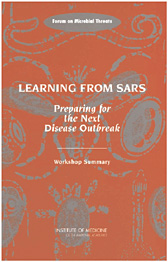
PANDEMIC INFLUENZA
Infectious disease experts believe that a future influenza pandemic is inevitable. Yet despite the legacies of the 1918 “Spanish flu” pandemic that killed an estimated 50 million to 100 million people and of the more recent 1957 and 1968 pandemics that claimed millions more, the general public appears relatively unaware about the next “killer flu” and the devastation it could create worldwide. Meanwhile, the danger of an influenza pandemic mounts due to the emergence in Asia of a highly pathogenic strain of avian influenza (H5N1) that shows some capacity to infect humans now, and a strong probability of mutating into a human virus. The world has no capacity to produce adequate amounts of influenza vaccine against this virus. In the face of this threat, the Forum held a workshop to examine the nation’s level of preparedness. The Threat of Pandemic Influenza: Are We Ready? (2005) describes a nation and world community that are woefully unprepared to meet the challenges that lie ahead. To help in moving forward, the report explores a broad range of medical, technical, social, economic, and political opportunities for enhancing pandemic preparedness, and details the many obstacles that stand in the way of achieving this goal.
THE RELATIONSHIP BETWEEN INFECTIOUS AND CHRONIC DISEASES
Chronic diseases cause 70 percent of all deaths in the United States, yet the factors that cause many of these conditions are poorly understood. In recent years, however, the picture has begun to change. A number of chronic diseases have been discovered to be caused by infectious agents. For example, the
human papillomavirus causes more than 90 percent of cervical cancers, and the bacterium Helicobacter pylori has been linked to a number of disorders, including peptic ulcers, gastric cancer, and certain types of lymphomas. Nor do connections stop with physical ailments; infections are increasingly being examined as associated causes of or contributors to a variety of serious chronic neuropsychiatric disorders and to developmental problems, especially in children. The Infectious Etiology of Chronic Diseases: Defining the Relationship, Enhancing the Research, and Mitigating the Effects (2004) summarizes a Forum workshop that explored the rapid scientific advances taking place in this field. The report reviews research linking diverse infections to chronic diseases, suggests chronic diseases and syndromes that warrant further investigation, identifies difficulties in linking infectious agents with chronic outcomes, and describes broad-based strategies and research programs that can contribute to improved understanding of the complex and intriguing connections between microbes and chronic ailments.
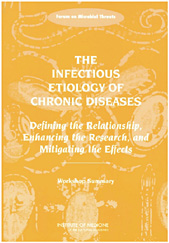
ROUNDTABLE ON ENVIRONMENTAL HEALTH SCIENCES, RESEARCH, AND MEDICINE
The Roundtable on Environmental Health Sciences, Research, and Medicine (EHS Roundtable) was established in 1997. It brings together participants from the academic community, federal government agencies, industry, public interest groups, and other organizations that are engaged in activities related to environmental health, research, and medicine. Environmental health issues are often particularly polarizing, and the opportunities for evidence-based dialogue that involves government scientific and regulatory agencies, public health professionals, consumer advocates, and public officials from the state and local level are rare. The EHS Roundtable identifies problems current, ongoing, or likely to arise within the next several years and orchestrates discussions to examine strategies to address them. It does not provide formal advice or recommendations, but shares knowledge and ideas.
Environmental health issues are often particularly polarizing, and the opportunities for evidence-based dialogue that involves government scientific and regulatory agencies, public health professionals, consumer advocates, and public officials from the state and local level are rare. The EHS Roundtable identifies problems current, ongoing, or likely to arise within the next several years and orchestrates discussions to examine strategies to address them.
ESTABLISHING A UNIFYING VISION FOR ENVIRONMENTAL HEALTH
The first EHS Roundtable workshop explored the connection between human health and the natural environment that surrounds people, the “built” environment that they have designed and constructed, and the social environment in which they interact with one another. In Rebuilding the Unity of Health and the Environment: A New Vision of Environmental Health for the 21st Century (2001), workshop participants suggest that the infrastructure for linking environmental health and public health is not working as well as it should. Discussions of environmental health have become too narrowly focused around regulations, and particularly the effects of regulations on economic growth. Instead, the focus should be on creating and maintaining an environment that is healthy and livable for humans and other species, while absorbing population growth and enabling manufacturing and agriculture to thrive. The EHS Roundtable has used the overarching themes from this workshop as the framework for its convening activities.
CONSIDERING ONE CITY’S EXPERIENCE
Taking the concept “on the road,” the EHS Roundtable met in Pittsburgh, a quintessential postindustrial city whose past featured the dirtiest of work-places. Today, the city boasts cleaner air and water, new businesses and residences where major industrial facilities once stood, and a strong focus on developing knowledge-intensive activities in its government, industrial, and academic institutions. In Ensuring Environmental Health in Postindustrial Cities (2003), workshop participants use Pittsburgh as a model for examining the variety of complex issues facing many urban areas in the United States and worldwide. Several cross-cutting themes are central to strategies for achieving environmental health. Among them, cities can take advantage of the genuine concern that policymakers and the general public have for the environment, involve the public and all stakeholders early and often, form partnerships among public and private institutions and groups, integrate environmental goals with goals for economic growth, determine the true costs and benefits of possible actions, and understand the consequences of inaction. Participants also identify a number of promising areas for research—from basic studies to better understand the effects of pollutants at the cellular level to applied studies on how to design communities that are livable and promote good health.
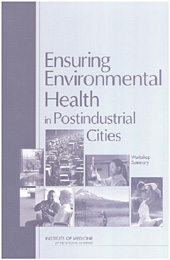
EFFECT OF THE ENVIRONMENT ON PREMATURE BIRTHS
Each year in the United States, more than 440,000 babies are born prematurely. Compared with full-term babies, premature infants have a much greater chance of dying, having breathing problems, or suffering such lifelong medical problems as cerebral palsy, visual and hearing disabilities, and mental retardation. Although vast improvements have been made in treating premature infants, there has been less success in understanding and preventing prematurity. Cigarette smoking, disorders that raise blood pressure, and certain complications of pregnancy make well-recognized contributions to the risk of prematurity, but they account for only a small amount of the problem. Recent research suggests that some environmental factors, including exposure to chemical agents and toxins, also may play important, though as yet unspecified, roles in determining a woman’s risk of delivering a preterm baby. An EHS Roundtable workshop to explore possible connections is summarized in The Role of Environmental Hazards in Premature Birth: Workshop Summary (2003). Among their observations, participants stress the importance of improved interactions across disciplines—particularly among epidemiologists, reproductive biologists, and toxicologists—to elucidate the role of social and environmental factors, genetic factors, and gene-environment interactions in influencing preterm births. Having this information in hand will be invaluable in developing and implementing public health strategies to reduce the number of women delivering premature babies.
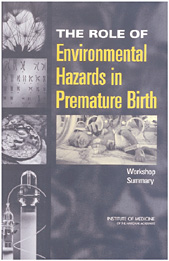
CLINICAL RESEARCH ROUNDTABLE
Clinical research is the essential intermediary or translation between basic science and medical treatment—yet for many years it has been a neglected part of the research enterprise. From 2000 to 2005, the Clinical Research Roundtable (CRR) played an important role in forming a shared vision to improve understanding of and support for this critical area of medical science. The CRR provided a venue where all of the primary players—including stakeholders in the clinical research enterprise who are not always represented in other venues—could discuss the challenges facing clinical research and possible approaches to resolving them. The discussions enabled a meeting of the minds among diverse parties who, absent the experience, would not have gained an appreciation for the risks, opportunities, limitations, and resources of one another.
The CRR conceptualized the relationship between medical research and clinical practice as a continuum involving two translational blocks—the first from laboratory to clinic, and the second from clinical research to improved clinical practice. A corollary of the framing accomplishment was that the CRR created an understandable vocabulary to clearly distinguish between different elements of the translational blocks. The CRR published six workshop summaries and its members published ten independently authored articles concerning CRR discussions. In addition, 38 articles concerning CRR discussions were published in various media outlets.
The CRR provided a venue where all of the primary players—including stakeholders in the clinical research enterprise who are not always represented in other venues—could discuss the challenges facing clinical research and possible approaches to resolving them.
Several stakeholders referenced these works in support of their activities. For example, an article describing some of the CRR’s findings—“Central Challenges Facing the Nation’s Clinical Research Enterprise,” published by Sung et al. in the March 2, 2003, issue of the Journal of the American Medical Association—was cited in the 2005 Senate Appropriation Committee Bill for the Departments of Labor, Health and Human Services, and Education and Related Agencies; in the American Association for the Advancement of Science 2003 Presidential Address; and in the National Institutes of Health’s Request for Application for Small Research Grants for Primary Care Practice-Based Research Networks.
Discussions at the CRR also influenced the Government Accountability Office’s report Implementation of the Clinical Research Enhancement Act and the United Kingdom’s Academy of Medical Sciences’ report Strengthening Clinical Research. In addition, the CRR provided input and influenced several National Academies reports.
Among other impacts, CRR discussions were instrumental in the Office of Human Research Protection’s decision to emphasize the importance of training clinical investigators relative to the protection of human subjects in research. Discussions concerning the clinical research workforce influenced changes in training grants at the American Diabetes Association. The CRR helped shape the National Institutes of Health Roadmap, particularly regarding activities related to reengineering the clinical research enterprise. The recent Centers for Medicare & Medicaid Services’ (CMS) Coverage with Evidence Development Policy Guidance publication, which proposes criteria under which the CMS can request formal data gathering as a condition of coverage under its existing National Coverage Determination process, was developed from CRR discussions.
The CRR also conducted several workshops on such important issues as the role of laypeople in clinical research. Recent years have brought a sea change to public participation. Consumers now demand a role in the formulation of the research agenda and in the design, review, and pursuit of research. Exploring Challenges, Progress, and New Models for Engaging the Public in the Clinical Research Enterprise (2003) summarizes ideas explored during a workshop on this issue. Engaging the public, although posing certain difficulties, is deemed a strategic imperative. The public can help in translating research findings into practice, in speeding up the clinical research process, and in making the research enterprise more efficient. For example, public support for research on coronary heart disease and support for and participation in AIDS trials have led to declines in the numbers of deaths from those diseases. Several strategies are available to support this movement. They include striving to gain and maintain the public’s trust in medical research, establishing two-way communication between scientists and patients, and mounting educational programs to provide patients with information about clinical research that is factual and does not raise unrealistic expectations.
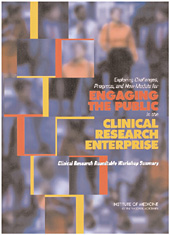
FOOD FORUM
Since 1993, the Food Forum has brought together leading scientists, administrators, and policymakers from government, industry, academia, and the public sector to discuss issues related to food, food safety, and the array of regulations that affect how food in produced and consumed.
Few subjects excite more interest than food—its safety, availability, health-fulness, and cost. The food and agriculture sector is large, dispersed, and fragmented. Since 1993, the Food Forum has brought together leading scientists, administrators, and policymakers from government, industry, academia, and the public sector to discuss issues related to food, food safety, and the array of regulations that affect how food in produced and consumed. Importantly, the Forum includes participation from the primary agencies that have regulatory authority in this area: the Food and Drug Administration and the Department of Agriculture. The Forum provides a rapid way to identify areas of concordance among diverse interest groups and to highlight emerging cross-sectoral issues. It does not produce policy recommendations or offer advice about specific issues. Recent discussions have focused on food allergies, food
traceability, risk communication, consumer research about qualified health claims, and the food industry’s role in addressing the obesity epidemic.
NATIONAL CANCER POLICY FORUM
The newly formed National Cancer Policy Forum is designed to enable government, industry, academic, and other representatives to meet and confer on subject areas of mutual interest. Likely discussions may cover issues in science, clinical medicine, public health, and public policy relevant to the goals of preventing, palliating, and curing cancer. The Forum will not produce policy recommendations or offer advice regarding specific issues. Rather, it will convene interested parties, compile authoritative information, and develop possible scientific and policy options for consideration. As other forums have demonstrated, the unofficial nature of the deliberations, the neutrality of the setting, and continuity presented by regular meetings should stimulate fresh thinking and promote frank exchanges of views. One topic of early interest to the Forum is how to design a national quality of cancer care system.
WORKSHOPS AND SUMMITS
Workshops and summits differ from forums and roundtables in that they are one time events, not a continuing engagement of the same members. Workshops and summits may issue a summary of discussions or a proceedings report.
QUALITY CHASM SUMMIT
In January 2004, the IOM convened the First Annual Crossing the Quality Chasm Summit, a high-energy endeavor designed to help move the nation closer to realizing the vision of the 2001 IOM report Crossing the Quality Chasm: A New Health System for the 21st Century. The summit focused particularly on issues and activities at the community level, as successful community innovations can provide a lens for viewing how to redesign care delivery systems, and involving community stakeholders can help mobilize the next round of quality improvement efforts. Communities also can serve as “laboratories of innovation” to assess what does and does not work prior to the adoption of a national policy. Additionally, working at the community level can strengthen
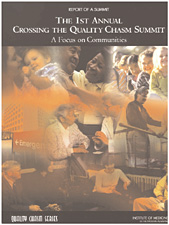
the interface between the personal and the population-based health systems. At the summit, representatives of innovative communities from across the country joined forces with national leaders and organizations to identify strategies for improving the quality of care for individuals with five common chronic conditions: asthma, depression, diabetes, heart failure, and advanced cancer requiring intensive pain control. Participants described strategies for advances—and opportunities for overcoming barriers to such advances—in six key areas: measurement, information and communications technology, care coordination, patient self-management support, finance, and community coalition building.
The spirit, knowledge, and commitment of the participants are reflected in the resulting IOM report, The 1st Annual Crossing the Quality Chasm Summit: A Focus on Communities (2004), which synthesizes the strategies and action plans proposed to improve health care. The plans will need to be further refined and modified for different settings, but the message is clear—change is possible. With future support, the IOM hopes to convene future summits that build on the vision of Crossing the Quality Chasm and looks forward to hearing about the continued progress that communities make in delivering high-quality care.
SCREENING FOR COLORECTAL CANCER
Colorectal cancer is the second leading cause of death from cancer in the United States. Screening adults for early cancers or their precursor lesions, followed by appropriate therapy and continued surveillance, can reduce the incidence and mortality of colorectal cancer. There is general consensus that periodic screening of adults over age 50 is a valuable preventive intervention, and today most health plans cover such screening. Yet, there is uncertainty about the specific screening strategies that should be offered to at-risk individuals. Cost-effectiveness analysis models offer a means of comparing screening strategies, but current models disagree about how alternative strategies stack up against one another. Understanding the reasons for such differences is therefore an important first step in building confidence among policymakers and the public that the models can, in fact, provide objective and informative insights into the consequences of health policy choices. Economic Models of Colorectal Cancer Screening in Average-Risk Adults: Workshop Summary (2005) explores the reasons for differences among the leading models. After running their models using a variety of standardized inputs, workshop participants discussed the five models, examining differences among their structures and assumptions and possible explanations for their varied results. Participants also examined the current state
of knowledge on key inputs to the models, with a view toward identifying areas where further research may be warranted. An obvious next step would be for modelers and clinicians to continue working together to identify and explore critical sources of variations and thereby reduce conflicting findings.
LIFESTYLE CHOICES AND HEALTH: ESTIMATING RISKS
Lifestyle choices—including smoking, alcohol consumption, poor diet, and physical inactivity, among others—are known to affect health and well-being. But to what extent? In recent years, the Centers for Disease Control and Prevention (CDC) and other organizations have attempted to quantify and interpret the contributions of lifestyle-related factors to preventable death. In 2004, the CDC published a study in the Journal of the American Medical Association that estimated the numbers of preventable deaths linked to a range of lifestyle choices—and controversy emerged, about both the study’s conclusions and its methodology. At the request of the CDC, the IOM convened a workshop to bring together experts in a variety of disciplines to review methodologies and explore broader scientific challenges involved in assessing the health effects of lifestyle choices. Estimating the Contributions of Lifestyle-Related Factors to Preventable Death (2005) summarizes the deliberations. No “perfect” solution emerges, but participants identified areas where advances would be valuable.
COMMUNICATING THE RESULTS OF IOM REPORTS
Workshops also serve as important opportunities for stimulating action on completed IOM studies, and they provide an effective means of communicating the results of studies to key audiences. One example centers on an influential IOM report—Calling the Shots: Immunization Finance Policies and Practices (2000)—on childhood immunization. The report focused national attention on the uncertainties and instabilities of the public health infrastructure that supports immunization programs, and proposed several strategies to address these concerns and to provide an adequate funding level for the immunization infrastructure. To help catalyze reforms, the CDC asked the IOM to undertake a special effort to foster discussions among the various public and private groups who participate directly or indirectly in the immunization system. In response, the IOM held a series of four workshops across the country designed to increase awareness of the report’s conclusions and recommendations; build consensus
Workshops also serve as important opportunities for stimulating action on completed IOM studies, and they provide an effective means of communicating the results of studies to key audiences.
for initiatives to redesign the infrastructure of the immunization system, measure its performance, and finance its operations; and identify unresolved public health and health finance issues and concerns at the regional, state, and local levels that require further attention from public and private policymakers.
COMPLETE LIST OF CURRENT IOM FORUMS AND ROUNDTABLES
-
Roundtable on Biomedical Engineering Materials and Applications (joint with National Research Council)
-
Forum on Drug Discovery, Development, and Translation
-
Roundtable on Environmental Health Sciences, Research, and Medicine
-
Roundtable on Evidence-Based Medicine
-
Food Forum
-
Forum on Microbial Threats
-
National Cancer Policy Forum
WORKSHOP SUMMARIES
CLINICAL RESEARCH ROUNDTABLE
-
Exploring Challenges, Progress, and New Models for Engaging the Public in the Clinical Research Enterprise: Workshop Summary
-
The Role of Purchasers and Payers in the Clinical Research Enterprise: Workshop Summary
-
Public Confidence and Involvement in Clinical Research: Symposium Summary, Clinical Roundtable, September 2000
-
Exploring the Map of Clinical Research for the Coming Decade: Symposium Summary, Clinical Roundtable, December 2000
-
Summary of the June 2000 Meeting of the Clinical Research Roundtable
ROUNDTABLE ON ENVIRONMENTAL HEALTH SCIENCES, RESEARCH, AND MEDICINE
-
Rebuilding the Unity of Health and the Environment: A New Vision of Environmental Health for the 21st Century: Workshop Summary
-
Cancer and the Environment: Gene-Environment Interactions: Workshop Summary
-
Health and the Environment in the Southeastern United States: Rebuilding the Unity: Workshop Summary
-
The Role of Environmental Hazards in Premature Birth: Workshop Summary
-
Ensuring Environmental Health in Postindustrial Cities: Workshop Summary
-
Environmental Health Indicators: Bridging the Chasm of Public Health and the Environment: Workshop Summary
-
From Source Water to Drinking Water: Workshop Summary
-
Public Health Risks of Disasters: Communication, Infrastructure, and Preparedness: Workshop Summary
-
Rebuilding the Unity of Health and the Environment, The Greater Houston Metropolitan Area: Workshop Summary
-
Implications of Nanotechnology for Environmental Health Research: Workshop Summary
FORUM ON MICROBIAL THREATS
-
The Threat of Pandemic Influenza: Are We Ready?: Workshop Summary
-
The Infectious Etiology of Chronic Diseases: Defining the Relationship, Enhancing the Research, and Mitigating the Effects: Workshop Summary
-
Learning from SARS: Preparing for the Next Disease Outbreak: Workshop Summary
-
The Resistance Phenomenon in Microbes and Infectious Disease Vectors: Implications for Human Health and Strategies for Containment: Workshop Summary
-
Biological Threats and Terrorism: Assessing the Science and Response Capabilities: Workshop Summary
-
The Emergence of Zoonotic Diseases: Understanding the Impact on Animal and Human Health: Workshop Summary
-
Considerations for Viral Disease Eradication: Lessons Learned and Future Strategies: Workshop Summary
-
Emerging Infectious Diseases from the Global to the Local Perspective: Workshop Summary
-
Managed Care Systems and Emerging Infections: Opportunities for Strengthening Surveillance, Research, and Prevention: Workshop Summary
-
Public Health Systems and Emerging Infections: Assessing the Capabilities of the Public and Private Sectors: Workshop Summary
-
Antimicrobial Resistance: Issues and Options: Workshop Summary
-
Orphans and Incentives: Developing Technologies to Address Emerging Infections: Workshop Summary














